
Manistique High School Senior, Logan Kraatz, is congratulated by Larry Peterson of the Schoolcraft County Historical Society. Logan won 1st place in the recent essay contest and received an award of $350. He will attend the University of Michigan in the fall.
Historic Siphon Bridge and River Flume
By Logan Kraatz
Anyone traveling through downtown Manistique is sure to cross the Siphon Bridge and massive paper mill flume. This bridge crosses the concrete flume and Manistique River. Not only are these structures cool to look at, they also fill a very important part in the history of Manistique. Many will just look at them and think nothing more. However, some will look at them and instantly be filled with questions. Questions like: why are they here, what did they do, what happened to them, and why were they needed? Manistique is divided east and west by the Manistique River. The river was an obstacle for citizens as well as a source of power and industry for the town. Naturally a bridge had to be constructed to connect the two sides. The first bridge to fill this need was the “Red Bridge.” It was a simple wooden flat bridge constructed in the mid to late 1800s. The bridge was condemned in 1890 and replaced by a [metal] bridge dubbed the “Iron Bridge.” This bridge was ultimately replaced by the siphon bridge and scrapped to be used for other projects.
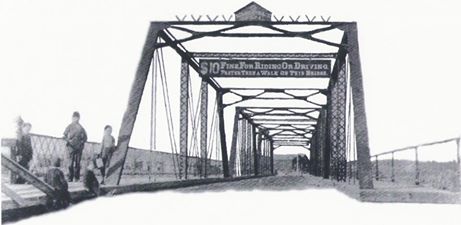
The “Iron Bridge” over the Manistique River stood for nearly 30 years before being replaced by the Siphon Bridge.
In 1916 construction began on the Manistique Pulp and Paper Mill. The mill was constructed by W. J. Murphy who owned the Minneapolis Tribune. The Manistique Light and Power Company was also bought by Murphy and added to the mill operations. During construction it was quickly realized that a larger supply of power was needed. To solve this problem they decided to use the waterpower provided by the river. This however became an issue due to the fact that the water had to be harnessed so the waterpower could be used effectively. A dam would have been impossible to build in this area because it would flood the entire town and they couldn’t put a waterwheel in the river or the water would just flow around it. Eventually they came up with the idea to build a large dam upstream and channel the water by use of a flume/canal. Soon after completion of the mill, construction began on a dam and concrete flume. This system was designed to raise the level of the river in order to increase the effect of the water on the mill’s power system. Over 650,000 gallons of water flowed through per hour.
Now that the waterpower problem was solved another issue arose. They would need to construct another bridge to replace the old Iron Bridge that was in the way of the flume. The only problem was that a traditional bridge was rendered useless due to the high walls of the flume. The design that seemed to stick involved building a bridge that cut right through the flume and raised water. Involving a roadway below water level the bridge would feature thick high walls that would protect the roadbed and anyone crossing. Shortly thereafter construction began on the
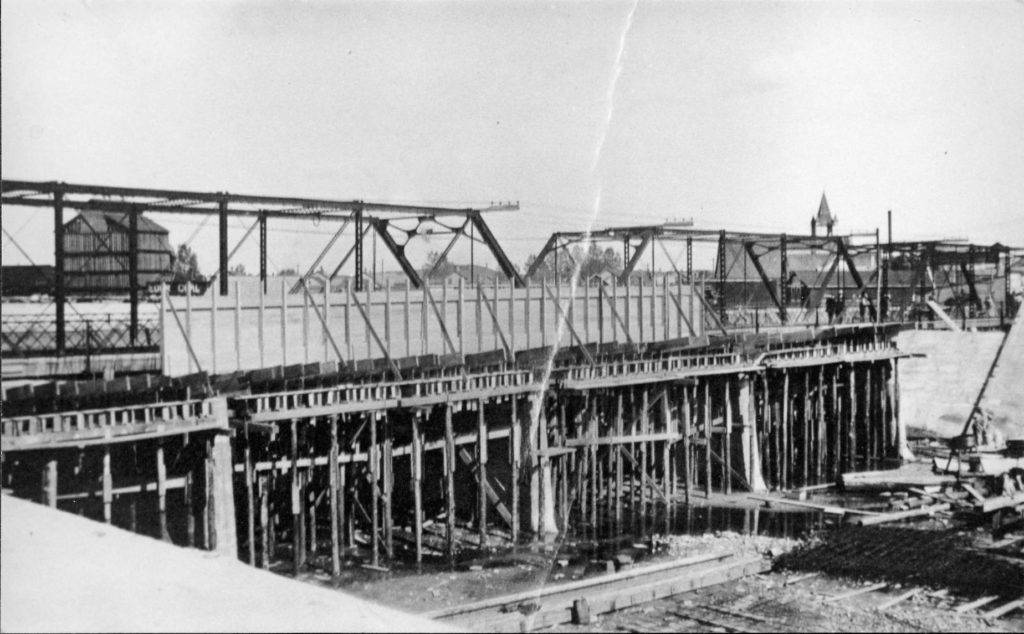
The above is an image of the early phase of construction of the siphon bridge showing remnants of the iron bridge.
revolutionary Siphon Bridge and demolition began on the old iron bridge. The [metal] girders from that iron bridge were used for building projects throughout the county. In 1919 the Siphon Bridge was completed and quickly became an iconic feature of Manistique. Using the rushing water and atmospheric pressure to help uphold it, the bridge became popular all over the country. It was deemed the “Floating Bridge” and landed a spot in “Ripley’s Believe It or Not.”

The above is a 1970s image of the siphon bridge showing the water in the flume above the roadway surface and the “Believe It or Not” sign on the bridge.
The mill was now ready for production except for one little hiccup. The spring of 1920 experienced warmer than usual weather and exceptional amounts of melting snow. The tributaries of the Manistique River began to swell causing water to build up behind the newly constructed dam. An ice jam on the Driggs River, one of the tributaries, had been building up water for some time now storing a potential battering ram of energy. When that jam finally broke on Palm Sunday (March 28, 1920) a torrent of water came rushing into the build up of water already behind the dam. This sudden increase of water caused an earthen wall on the west bank of the river to crumble sending water into Deer St. and the west side of town destroying everything in its path.
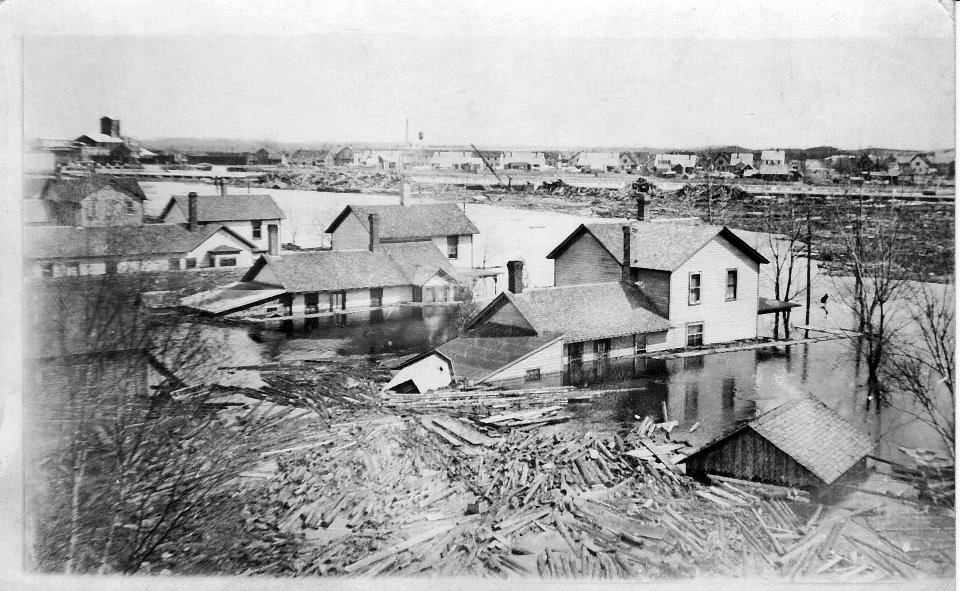
Homes on Weston Avenue were flooded to the second story. Note the large amount of lumber and other floating debris.
Homes were pushed off their foundations as logs and other debris were slammed into buildings. Telephone poles along with much of the town’s lumber and raw materials were swept into the river. Most all of the industrial buildings on the west side of town were destroyed including many homes and businesses. The newly constructed pulp and paper mill was badly damaged as water and logs flew through the first floor upending equipment and smashing windows. To make matters worse, the town’s generators were now located on the first floor of the mill. By Monday the city’s power was knocked out and the rushing waters were at their highest point. Many homes were under several feet of water as residents fled to safety. Within 12 hours of the power being taken out, temporary poles were placed and a dike was erected around the generating room in the mill. The outage lasted around 12 hours but the flood lasted nearly two days. Nearly $1,500,000 in damage was suspected along with the loss of many of the town’s industries. The flume and siphon bridge remained intact surprisingly, and the pulp and paper mill was quickly repaired. Production finally began in May of 1920.
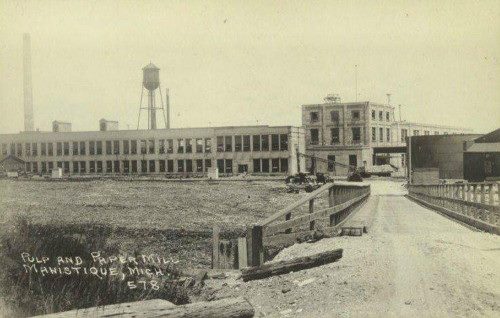
The paper mill was quickly repaired following the flood of 1920.
The area around the flume got a quick face lift as many of the industrial buildings were torn down and businesses left as a result of the flood. As part of a new water system the historic water tower and pumping station was built adjacent to the siphon bridge. This system used gravity to feed the water behind the dam into a white pine water main. That main was connected to the pumping station which pumped the water into a 200,000 gallon storage tank. The tower features a Romanesque design and also achieved national status was well as being added as a State and National Historical site. It was replaced by a pressure fed system after the gravity main was damaged in 1954. It now is the site of the Schoolcraft County Historical Society Museum and gift shop.
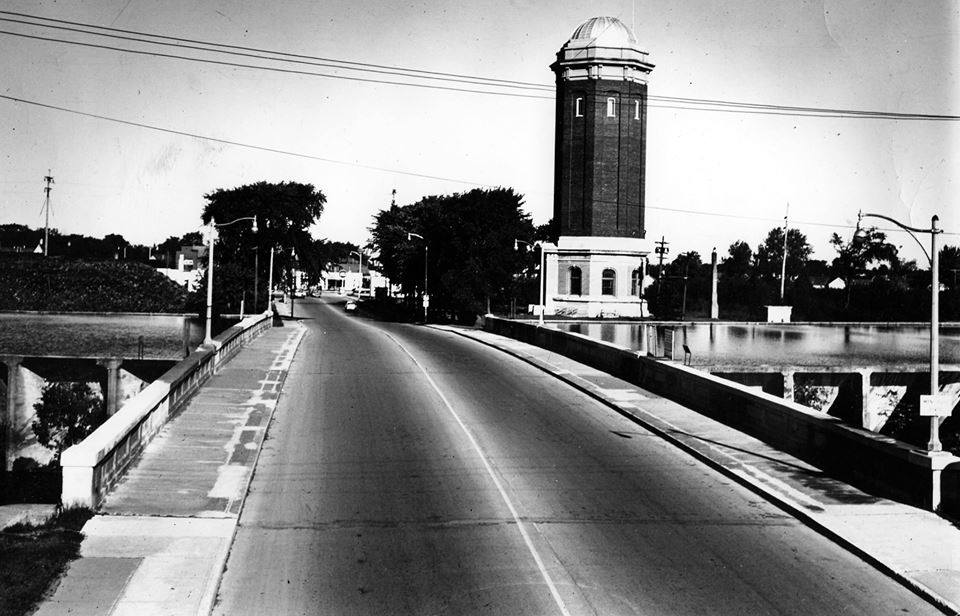
Above is a 1970s image of the Siphon Bridge, flume and water tower.
As time went on the pulp and paper mill received many upgrades eventually making the need for waterpower obsolete. The water level within the flume was lowered rendering the term “Floating Bridge” obsolete as well. To further prevent flooding a section of the flume wall was cut shorter letting the water flow right through. A section of the siphon bridge over the free flowing part of the river has also since been rebuilt. These two idle structures stand a shadow of what they once were. The mill has since closed and there is a small sliver of hope that it may reopen. If it is scrapped this flume and the bridge will be one of the only reminders of Manistique’s industrial past. History shapes who a people are just as history shapes this town. The flume and Siphon Bridge will continue to shape Manistique as long as they are not forgotten.
More Next Week From Our Essay Contest
Next week we will feature some excerpts from the 2nd prize winner in our essay contest regarding businesses in Manistique.
